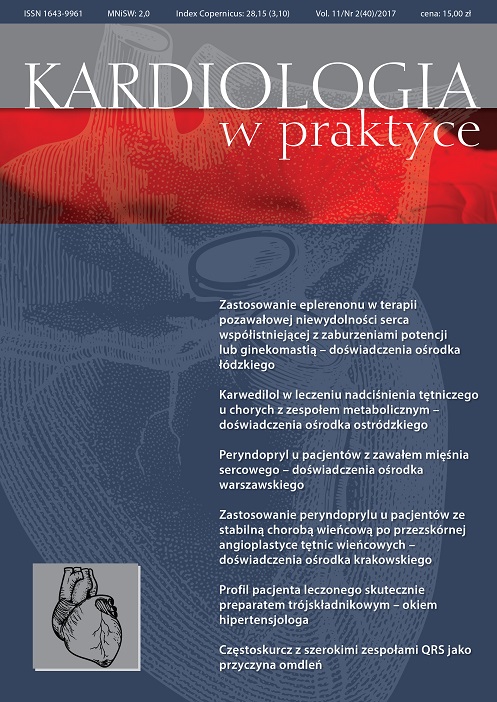Peryndopryl u pacjentów z zawałem mięśnia sercowego ? doświadczenia ośrodka warszawskiego Opis przypadku
##plugins.themes.bootstrap3.article.main##
Abstrakt
Przedstawiono krótkie podsumowanie danych dotyczących częstości występowania zawału serca, a także rokowania pacjentów w Polsce. Ze względu na wpływ na poprawę rokowania kluczowym elementem terapii chorych z ostrym zespołem wieńcowym jest wczesne (w ciągu 24 h) wdrożenie inhibitorów enzymu konwertującego angiotensynę (ACE-I), szczególnie u pacjentów z objawami niewydolności serca, dysfunkcja? lewej komory, cukrzyca? lub zawałem ściany przedniej. Na tle tej grupy wyróżnia się peryndopryl, którego metabolit ma długi czas półtrwania (17 h). Sugeruje się, że lek ten ma właściwości plejotropowe, przejawiające się m.in. wpływem na blaszkę miażdżycową oraz poprawą funkcji mięśnia lewej komory, co z kolei przekłada się na korzystne działanie w prewencji zdarzeń sercowo-naczyniowych. Poniżej przedstawiono 2 przykłady zastosowania peryndoprylu u pacjentów po zawale serca.
Pobrania
##plugins.themes.bootstrap3.article.details##

Utwór dostępny jest na licencji Creative Commons Uznanie autorstwa – Użycie niekomercyjne 4.0 Międzynarodowe.
Copyright: © Medical Education sp. z o.o. This is an Open Access article distributed under the terms of the Attribution-NonCommercial 4.0 International (CC BY-NC 4.0). License (https://creativecommons.org/licenses/by-nc/4.0/), allowing third parties to copy and redistribute the material in any medium or format and to remix, transform, and build upon the material, provided the original work is properly cited and states its license.
Address reprint requests to: Medical Education, Marcin Kuźma (marcin.kuzma@mededu.pl)
Bibliografia
2. Task Force on the management of ST-segment elevation acute myocardial infarction of the European Society of Cardiology (ESC), Steg P.G., James S.K., Atar D. et al.: ESC Guidelines for the management of acute myocardial infarction in patients presenting with ST-segment elevation. Eur. Heart J. 2012; 33(20): 2569-2619.
3. Savarese G., Costanzo P., Cleland J.G. et al.: A meta-analysis reporting effects of angiotensin-converting enzyme inhibitors and angiotensin receptor blockers in patients without heart failure. J. Am. Coll. Cardiol. 2013; 61(2): 131-142.
4. Fox K.M., Bertrand M.E., Remme W.J. et al.: Efficacy of perindopril in reducing risk of cardiac events in patients with revascularized coronary artery disease. Am. Heart J. 2007; 153(4): 629-635.
5. Remme W.J., Deckers J.W., Fox K.M. et al.: Secondary prevention of coronary disease with ACE inhibition ? does blood pressure reduction with perindopril explain the benefits in EUROPA? Cardiovasc. Drugs Ther. 2009; 23(2): 161-170.
6. Ceconi C., Francolini G., Olivares A. et al.: Angiotensin-converting enzyme (ACE) inhibitors have different selectivity for bradykinin binding sites of human somatic ACE. Eur. J. Pharmacol. 2007; 577(1-3): 1-6.
7. Nearchou N.S., Tsakiris A.K., Lolaka M.D. et al.: Influence of perindopril on left ventricular global performance during the early phase of inferior acute myocardial infarction: assessment by Tei index. Echocardiography 2003; 20(4): 319-327.
8. Ferrari R.; Perindopril and Remodeling in Elderly with Acute Myocardial Infarction Investigators: Effects of angiotensin-converting enzyme inhibition with perindopril on left ventricular remodeling and clinical outcome: results of the randomized Perindopril and Remodeling in Elderly with Acute Myocardial Infarction (PREAMI) Study. Arch. Intern. Med. 2006; 166(6): 659-666.
9. Nicolosi G.L., Golcea S., Ceconi C. et al.: Effects of perindopril on cardiac remodelling and prognostic value of pre-discharge quantitative echocardiographic parameters in elderly patients after acute myocardial infarction: the PREAMI echo sub-study. Eur. Heart J. 2009; 30(13): 1656-1665.
10. Piepoli M.F., Hoes A.W., Agewall S. et al.; 2016 European Guidelines on cardiovascular disease prevention in clinical practice: The Sixth Joint Task Force of the European Society of Cardiology and Other Societies on Cardiovascular Disease Prevention in Clinical Practice (constituted by representatives of 10 societies and by invited experts): Developed with the special contribution of the European Association for Cardiovascular Prevention & Rehabilitation (EACPR). Eur. J. Prev. Cardiol. 2016; 23(11): NP1-NP96.
11. Cleland J.G., Tendera M., Adamus J. et al.: The perindopril in elderly people with chronic heart failure (PEP-CHF) study. Eur. Heart J. 2006; 27(19): 2338-2345.
